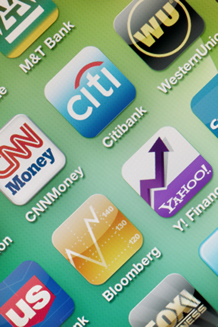
Reliant on Mobile
 Industry analysts agree that community banks are lagging behind the big banks when it comes to mobile technology. A recent survey from Celent, a research and consulting firm based in Boston, showed that among those surveyed, more than 80 percent of banks with $50 billion in assets or more offered an iPhone or Android mobile app, while for those with less than $1 billion in assets, the number hovers around 50 percent. Community banks “typically aren’t trying to compete on technology with the big banks. They can’t,” explains Bart Narter, senior vice president of banking at Celent. “The community bank’s competitive advantage is not [in] technology, but in personal relationships.”
Industry analysts agree that community banks are lagging behind the big banks when it comes to mobile technology. A recent survey from Celent, a research and consulting firm based in Boston, showed that among those surveyed, more than 80 percent of banks with $50 billion in assets or more offered an iPhone or Android mobile app, while for those with less than $1 billion in assets, the number hovers around 50 percent. Community banks “typically aren’t trying to compete on technology with the big banks. They can’t,” explains Bart Narter, senior vice president of banking at Celent. “The community bank’s competitive advantage is not [in] technology, but in personal relationships.”
However, community banks are seeing benefits from offering a mobile banking application. Banks that offer a mobile app can expect to see “fewer calls to the call center, which costs money. They’re going to get fewer visits to the branch,” says Narter.
Reliant Bank, a $372-million asset bank headquartered in Brentwood, Tennessee, introduced a mobile app just last August. Brian Shaw, chief retail and deposit officer at the privately owned bank, believes that the mobile app can expand the bank’s reach. Unlike larger banks, he says, “we’re not going to have a location on every corner.” Customer expectations also drive community banks, including Reliant, toward offering a mobile app. Darrell Freeman, a director and co-founder of the six-year-old bank, says that it’s important that Reliant Bank develop products that differentiate it from other community banks.
Shaw and Vice President of Marketing Marion Ingram pushed for the mobile app, although it became a bank-wide effort with the support of a tech-savvy board. “We believe that the consumer has already embraced mobile products,” says Freeman.
The board wanted to get the best value, which meant ensuring the “safety and security of the product” as well as delivering a user-friendly app, says Freeman. Ingram researched vendors and products thoroughly, but ended up selecting a vendor the bank knew—FiServ, which already served as the bank’s core processor. Most community banks purchase mobile apps through their core vendor so they can easily integrate the app with the bank’s core systems, says Narter.
FiServ was also able to offer a mobile app specifically branded for Reliant, instead of a generic, non-branded mobile app. “It looks very similar to our online presence, so customers already see something that they’re very familiar with,” says Ingram. The bank paid roughly $35,000 for development of the app, which included integration, implementation, and employee training. Of the total, $10,000 was spent on app customization, which included branding. Ingram says that the additional investment is worth it, as the bank seeks to further establish itself online as well as remain recognizable to current customers. Developmental costs also included the integration of online bill pay (Ingram was unable to divulge how much bill pay contributed to developmental costs at press time). Per user costs were negotiated, and though Shaw declined to provide specifics, these costs tend to average $1 per user per month, says Narter.
What about banks that don’t feel they’re ready for a fully branded mobile app? Packaged apps are available from a variety of vendors, including so-called “wrapper apps” that can direct to the bank’s website. Narter also explains offering a mobile-ready website could be advantageous for a community bank, as it does not require building separate versions for iPhone and Android. However, “[mobile] apps can do more,” explains Stephen Greer, an analyst in Celent’s banking group, “[they] have a better user experience in general.”
The bank has been pleased with the reviews from customers, who have commented that Reliant’s mobile app is fast and user-friendly. Reliant has set an initial two-month goal to get one half of current online banking bill pay customers signed up as mobile app users, although bank officers declined to say how many customers that is. “Within the first 30 days of launch, we’ve reached 42 percent of the initial goal,” Ingram says, “so we are very pleased with that number.” The number of users continues to grow as the bank spreads the word on the app through email campaigns, Facebook contests, and monthly statements. The bank’s customers “have been waiting for [the app],” she says. “They’ve been very patient.”



